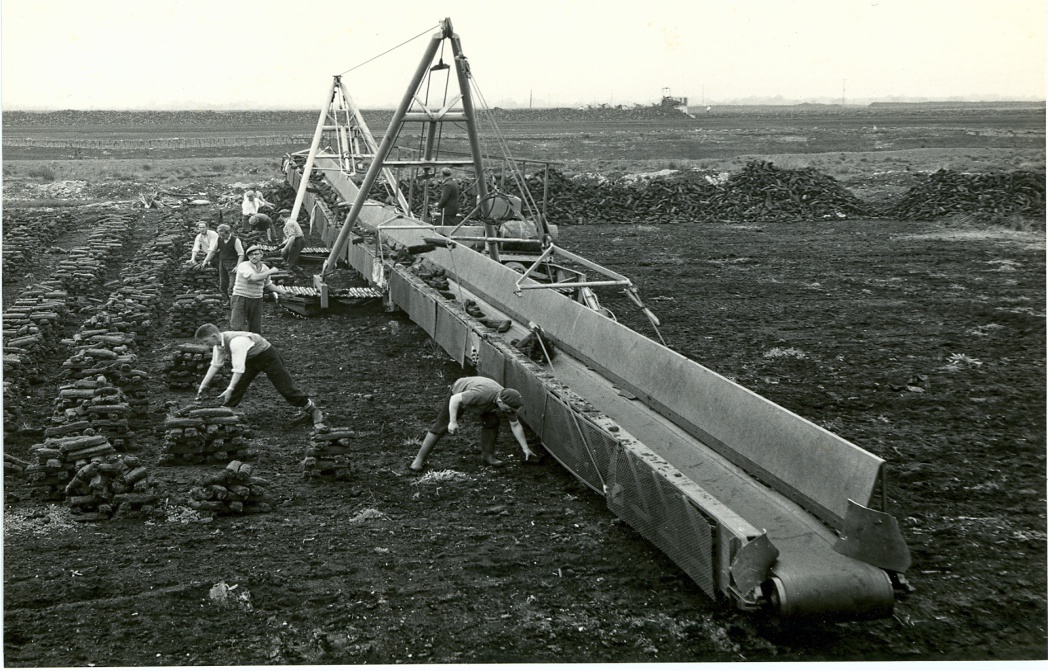History
The history of Kilcormac and the surrounding area is as rich as it is long. It weaves from the Mesolithic Era, through religious lore and myth, the ravages of Cromwell, and on to a heyday and renaissance of industrial heritage, leading into modern day.
Ancient History
The raised bogs of the Midlands of Ireland evolved after the last Ice Age, around 15,000 years ago. The Kilcormac area’s history goes right back to the Mesolithic era, following the discovery of the nearby Lough Boora Mesolithic site, which is dated 6800-6500 BC. This Mesolithic site is where charcoal remains, as well as other artifacts, from ancient campfires set up by Mesolithic hunters have been found. This discovery proved that the Midlands of Ireland were actually colonised over 3,000 years earlier than previously thought, making Lough Boora Mesolithic Site one of the most important archaeological finds in Ireland.
Just 3km from Kilcormac, the Lough Boora Mesolithic site is located within the Lough Boora Discovery Park.
To find out more about this, click here.
Religious History
Kilcormac boasts a very interesting and creative religious history. There is much lore and myth around the fascinating death of St. Cormac. A rare and historically important manuscript, the Kilcormac Missal was written here in the 14th Century and now resides in the Library in Trinity College, Dublin. The famous Pieta, a statue of Our Lady holding the body of Jesus, from the 16th Century, is located in the church in Kilcormac. Its very existence and survival is an intriguing story in itself – a symbol of the hardship suffered under Penal laws and brave local resistance to Cromwell and the Crown’s forces.
Kilcormac takes its name from Cormac Ua Liathain, also known as St. Cormac, a holy man from Cork who paid a visit to St. Colmcille at the famous monastery he had founded in Durrow in 553 A.D. Cormac was so inspired by the great saint that he joined Colmcille and spent many years at Durrow, eventually taking over as abbot after Colmcille had gone to Iona in Scotland. Cormac was a seafaring man and he went on a number of voyages searching for a peaceful place where he could devote his life to God. He eventually found his hermitage in the woods of Firceall, an ancient territory that comprised of what is now mid County Offaly, located beside the Silver River. From time to time, Cormac would retire to this place to pray and meditate. Eventually, this became Cill Chormaic, Cormac’s church, a place of worship for the people of the area who were honoured to have such a famous man in their midst.
Cormac died in the early years of the seventh century, supposedly from an attack by a pair of wolves. As time went on, St.Cormac’s church eventually fell into ruin. Although the name Kilcormac survived in the local townland, Ballyboy, situated on the highway through Firceall, was now the important centre in the area and in time gave its name to the parish and to the barony.
About five hundred years later reference is made to foreign monks, possibly Augustinian, at the Hermitage. A manuscript written in Kilcormac in 1300, giving it its name The Kilcormac Missal, is now in the Library of Trinity College, Dublin.
Another notable piece of religious history associated with Kilcormac is the famous Pieta – a statue carved in the 1500’s portraying the Virgin Mary holding the body of Jesus after he had been crucified and taken down from the cross. The only thing more astounding than the statue itself is the story behind its miraculous survival throughout the years.
Milling History
At one point, there were 13 mills on the Silver River, three of which were in the town of Kilcormac, including Williams Mill, Egan’s Mill and a distillery. Eventually the milling industry began to decline in the early 20th Century, making way for Bord Na Mona’s milled peat production industry to thrive.
“The most unaltered of all the county’s maltings is the one at Kilcormac, which still retains all its malting floors and double kiln at one end (fig 3.8). Its survival is undoubtedly due to its rural location which has not been subjected to the same development pressures as the maltings in the towns, and also due to it being kept in repair by its owner.” (https://www.offaly.ie/eng/Services/Heritage/Architecture/Mills-of-Offaly/)
Bord Na Móna
Bona Na Mona was established in the 1940’s to develop Ireland’s peat resources. This company produced milled peat, which was then used to generate electricity and manufacture peat briquettes. Milling is the process of harvesting peat from the surface of bog in the boglands and using it as a source of energy. The various stages included in the production of peat include milling, harrowing, ridging, harvesting, stock protection, covering, loading, and transport. The boglands of Kilcormac proved to be the perfect site for milled peat production. By commercially developing the boglands in the vast area around Kilcormac, Bord Na Mona provided a great source of employment, as well as vast energy sources for the region, making Kilcormac a bustling and thriving home to the multitude of workers who settled here from most counties in the country and other countries.
To find out more about Bord Na Móna’s history, check out the Living History website.
